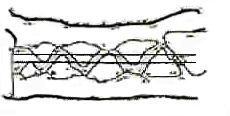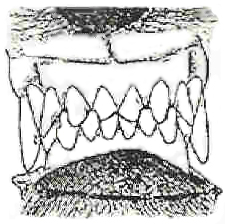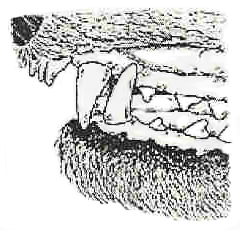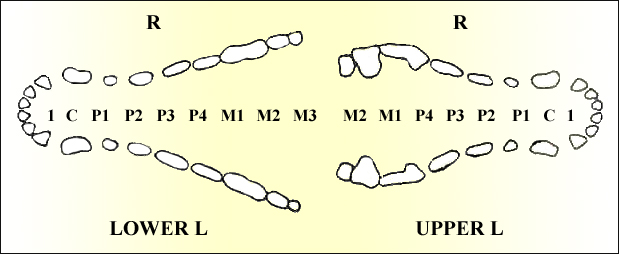| |
| When we think
about the canine anatomy, especially in the area of dentition
we must keep in mind that dogs are carnivores and have teeth that
reflect their meat-eating evolutionary history. In dogs,
food is bolted rather than chewed, and a complete occlusal surface
is not necessary. |
| |
| Breeders need to know
the number of teeth; the type of bite and how the incisors meet;
the relationship of the canine teeth, the premolars; the molars,
and jaw curvature. If there are any genetic inconsistencies,
this should be taken into consideration in the breeding program. |
| |
| In the Doberman Pinscher
standard the mouth is described as Teeth strongly developed and
white. Lower incisors upright and touching inside of the
upper incisors true scissors bite. 42 correctly placed teeth,
22 in the lower, and 20 in the upper jaw. Distemper teeth
shall not be penalized. Disqualifying Faults: Overshot
more than 3/16 on an inch. Undershot more than 1/8 of an
inch. Four or more missing teeth. |
| |
| In counting the teeth,
they are divided into 4 quadrants. Upper and lower left;
Upper and lower right. There are 3 upper left incisors;
1 upper left canine; 4 upper left premolars; 2 upper left molars.
It is the same for the upper right teeth. There are 3 lower
left incisors; 1 lower left canine; 4 lower left premolars; 3
lower left molars. It is the same for the lower right teeth.
Total teeth in an adult canine should be 42. There are 20
upper and 22 lower. |
| |
| When you hear the term
occlusion this describes the occlusal plane of the upper and lower
arches. The premolars should interdigitate from the second
premolars back to the cusps of the upper fourth premolar with
overlapping of the cusp tips. This means that the molars
should occlude to allow the cusps to function in crushing.
The premolars and molars should be aligned. When the occlusion
is good, there will be little open space between the upper and
lower teeth. The teeth will interlock with each other forming
a tight fitting interlocked jaw. The incisors will fit into
a scissors bite with the top incisors fitting in front of the
bottom incisors tightly. They should not be level with
each other; they should not be overshot (open space between the
upper and lower incisors) or undershot (lower incisors fitting
in front of upper incisors). |
| |
| A common abnormality in
canine dentition is retention of deciduous (baby) teeth.
This occurs when the permanent teeth bud does not grow immediately
beneath the deciduous tooth, and therefore does not cause the
roots of the deciduous tooth to be resorbed. Often there
is a missing adult tooth underneath a retained baby tooth.
If a retained tooth causes the permanent tooth to erupt in an
abnormal position (often the case of canine tooth retention) it
should be extracted. |
| |
| Another bite abnormality is the wry
bite. An abnormal occlusion caused by a difference in length
of the upper and lower jaw bones. The abnormality results
in a variety of different jaw relationships as one side of the
jaw grows faster than the other and distorts or twists the mouth
giving it a wry appearance. This condition is quite a
handicap and leads to difficulty in grasping and chewing food
as well as retrieving game. |
| |
| Since missing teeth and poor occlusion
are genetic mutations, breeders must consider this in planning
their breeding programs. Large strong teeth also indicate
good bone texture in the skeleton. |
|

Normal occlusion side view |

Normal
occlusion frontal view |
|

Overshot
mouth |
Illustrations
reprinted from Veterinary Dental Techniques
Steven Holmstrom, DVM, Patricia Frost, DVM,
Ronald Gammon, DVM
W.B. Saunders Company 1992
|
|

Illustration
reprinted from
Versatile Hunting Dog Magazine,
December
2001 Dental Anatomy of Dogs |
|

Illustration
reprinted from
The American Doberman Pincher Educational Foundation
|